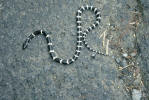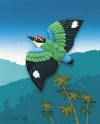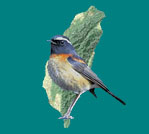|
TAIWAN TRIP REPORT,
November 10–19, 2003
Printable Version
Text: Jo Ann MacKenzie
LEADERS: Simon Liao and Ten-Di Wu
Ten-Di
Wu and Simon Liao
(E) = Endemic
Taiwan is a mountainous
island in the South China Sea, about 140 km (90 miles) off the Chinese
mainland. The forested beauty of the island led Portuguese sailors in 1590
to name it Ilha Formosa, meaning “Beautiful Island.”
The tropic of Cancer passes through the southern part of the island.
This trip was similar to
our very successful trip last March, in that it took us to varied habitats.
However, most destinations were different from our previous trip, and we saw
more bird species.
Monday-Tuesday, Nov. 10-11; Day 1:
Vancouver, BC, Canada to Kukwang, Taiwan
Our EVA Airways flight
departed Vancouver at 1:00 a.m. on Monday, Nov. 10, and arrived at Chiang
Kai Shek International Airport at 6:15 a.m. after a flight of over 13 hours
(about an hour late, due to strong headwinds) on Tuesday, Nov. 11. We were
soon away, headed south. In the small city of Tongshih (northeast of
Taichung), we picked up co-leader Ten-Di Wu, and our group, now consisting
of 10, proceeded to the wetlands of the Dajshi River. Birds of this lowland
habitat included Plumbeous Redstart, Yellow-bellied Prinia, Black Drongo,
Brown Shrike, White Rumped Munia, and Nutmeg Mannikin.
Moving inland and up, we
birded our way to Dragon Valley Recreation Area, examining the Dajshi River
as we went, for a Brown Dipper that was seen by some of the group. We
arrived at the town of Kukwang,
and our overnight accommodation at the Police Office Resort. Afternoon
birding around the resort was hampered by strong wind, but we managed to
find Daurian Redstart and Varied Tit. We escaped the wind by driving into a
side valley where we birded until sunset, seeing Crested Serpent-Eagle,
Whistling Green Pigeon, Gray Treepie, Gray-capped Woodpecker and Black
Bulbul.
Wednesday,
Nov. 12: Day 2: Kukwang to An Ma Shan Forest Reserve
Some of the group were
up and out before 4:30 a.m.,
trying unsuccessfully to see a calling Collared Scops-Owl. A FORMOSAN
WHISTLING-THRUSH (E) was also calling, and glimpsed. As daylight
advanced we climbed the Shaulai Trail above the hotel area, finding
Yellow-browed Warbler, Black-browed Barbet, Gray Treepie and Gray-chinned
Minivet.
Leaving Kukwang, we
retraced part of yesterday’s drive back to Hsinche, then northeast again
toward An Ma Shan Forest Reserve. On the way, we stopped at Km 15, and had
excellent luck when we walked through a farming area just off the main
road. There were almost too many birds to look at in the lush foliage
lining a small stream: Collared Finchbill, Vinous-throated Parrotbill,
Streak-breasted Scimitar-Babbler, Arctic Warbler, Black-naped Monarch,
Rufous-capped Babbler, Gray-cheeked Fulvetta, Daurian Redstart and Nutmeg
Mannikin. A Rusty Laughing-Thrush was heard in a thicket.
|
Meanwhile, two of
the group had found a small, 30 cm (12 inch), black-and-white snake,
seemingly dead, on the farm road not far from our bus. When we returned
to the bus, some of us went to look at the snake. A few days later, we
learned the snake’s identity: a venomous Many-Banded Krait (Bungarus
multicinctus). This nocturnal species is very aggressive at night,
but, fortunately for us, tends to be calm and relaxed during the day. |
 |
We were lucky, both in
seeing a snake at all, that it was small, and that no harm resulted. A
person bitten by this species has a 50% chance of survival.
We continued up the road
to the bend at Km. 21, where we had a view over the valley below. Birds
seen included
TAIWAN TIT (E), WHITE-EARED SIBIA (E),
Crested Serpent Eagle, Crested Goshawk, Black-throated Tit and Fire-breasted
Flowerpecker.
By mid-afternoon, we
arrived at the An Ma Shan Forest Reserve entrance, at 2000 m (6561 ft.)
elevation, and 210 Trail. Except for three Eurasian Jays and some smaller
passerines, birdlife was very quiet, so we continued on to the An Ma Shan
Resort (Snow Mountain Resort) at 2300 m (7546 ft.) elevation, which would be
our base for the next day-and-a-half. After settling into our comfortable
cabins, we explored the forested grounds. At this “high mountain”
elevation, we anticipated more endemics. The first were some STEERE’S
LIOCICHLA (E) calling loudly as they foraged in the leaf litter, and
TAIWAN BARWING (E) feeding in shrubs. A Brown-headed Thrush and a party
of Eye-browed Thrush moved through the trees overhead. A Gray-faced
Woodpecker flew by. We headed into the resort restaurant for supper. The
night was cold, and we were glad that the beds had warm duvets.
Thursday,
November 13: Day 3: An Ma Shan Forest Reserve
At chilly 5:30 a.m., we
started our drive to Km 39, to the 2100 m (6889 ft.) elevation and 220
Trail. Along the trail at dawn, we heard TAIWAN PARTRIDGE (E) (two
of the group were able to see one, the only sighting of this species
on the trip); and the first MIKADO PHEASANT (E), again seen by
only a few. As the sun rose higher and the temperature climbed, more birds
were found: COLLARED BUSH ROBIN (E), Ashy Wood Pigeon, and
White-browed Bush Robin. We heard monkeys, then saw a troupe of Taiwan
Macaque working the trees high above the trail.
We returned to An Ma
Shan Resort in mid-morning, and saw more Taiwan Barwing, White-eared Sibia,
Steere’s Liocichla, and a White-browed Bush Robin.
In late morning, we
boarded our bus again, and drove to Hsiao Xai Shan, the highest elevation of
the trip, at 2600 m (8530 ft.) where we added some new species to our Trip
List: WHITE-WHISKERED LAUGHINGTHRUSH (E), FLAMECREST (E),
Gray-headed Bullfinch, Streak-throated Fulvetta, Eurasian Nutcracker,
Vinaceous Rosefinch, Brownish-flanked Bush-Warbler, and Russet Bush-Warbler.
Friday,
November 14; Day 4: An Ma Shan Forest Reserve to Douliu, Yunlin County.
A 5:30 a.m. start once
again, to return to 210 Trail to look for Mikado Pheasant. The pheasant
family that we hoped to see near the beginning of the trail did not appear,
so the group split up, some of us walking the trail as quietly as possible
with Ten-Di, the others staying back with Simon, watching (in vain) for the
pheasant family. Comparing notes later, those with Ten-Di had walked 2-3 km
along the trail, and tallied 4 Mikado Pheasant and 2 SWINHOE’S PHEASANT
(E).
TAIWAN YUHINA (E)
was common during our days in the high mountains, with over 100 of the small
birds seen.
It was time to leave the
An Ma Shan Forest Reserve, and we drove down toward the lowlands. On the
way, a Chinese Bamboo Partridge dashed across the road. Arriving at the old
city of Lukang,
we ate a delicious mostly-seafood lunch, and visited the nearby Matsu Temple,
which has stood for 400 years.
In mid-afternoon, when
the tide had retreated, we went to Hambao, on the coast of Taiwan Strait.
Among the species seen were Saunders’ Gull, Terek and Common Sandpipers,
Gray-tailed Tattler, Common Greenshank, Red-necked Stint, and 400 Ruddy
Turnstone. Taiwan is the most important wintering area in East Asia for
Ruddy Turnstone.
Driving on to the city
of Douliu, we settled into the very comfortable Metro Hotel.
Saturday,
November 15: Day 5: Douliu to Tainan
Senator Eva Yu and some
local birders accompanied us to Pillow Mountain to see bamboo habitat of the
Fairy Pitta. No pitas were present at this time of year, but we walked
through bamboo forest, noting Black-browed Barbet, Black-naped Monarch,
Streak-breasted Scimitar Babbler, with glimpses of Malayan Night-Heron.
Following the walk, we stopped at the Fairy Pitta Visitor Centre in Huben
village.
Proceeding to the coast,
we had a lunch at the appropriately-named Dong Shr (“It’s Delicious”)
seafood restaurant, followed by birding at the Puzih River, where we found a
Black-tailed Gull among the ducks and waders, Whiskered and White-winged
Tern, and a Cinnamon Bittern. In the Auogo wetland, we saw 5 White-breasted
Waterhen and a Barred Buttonquail.
In Tainan in the
evening, we enjoyed a traditional noodle supper at the 108-year-old Tantsi
noodle house.
Sunday,
November 16: Day 6: Tainan to Kenting
After breakfast, we went
to the Shihthau Reserve for more shorebirding. There were many herons and
egrets, a Yellow Bittern, many Common Moorhen, Black-winged Stilt, Pacific
Golden Plover, Red-necked Stint, Little Ringed Plover, Snowy Plover and East
Siberian Gull.
Continuing to the
Tsengwen River mouth, there is a well-developed viewing station for
observation of the wintering flock of over 500 Black-faced Spoonbill with
many interpretive displays. This was a major stop on our route, and we
spent some time observing the spoonbills and other waders. After lunch, Jo
Ann MacKenzie on behalf of our group, was presented with a Black-faced
Spoonbill painting by Mr. Chen-Yao Tai, Deputy Minister, Council of
Agriculture, Executive Yuan.
Next we went to
Kwangtien wetland, where we saw several Pheasant-tailed Jacana. Researcher
H. W. Chang explained the conservation work being done to maintain the
habitat necessary for the survival of Taiwan’s small population of this
nationally endangered “Water Chestnut Bird.” A group photo was taken, which
was kindly forwarded to us by Li-Juin Lin (Una).
We drove south to
Kenting, Taiwan’s tropical Far South, arriving after dark. Following
supper, we walked through the Night Market before returning our rooms in the
Police Office Resort. The weather was windy, and threatening showers.
Monday,
November 17: Day 7: Kenting to Chaiyi
Our “target bird” in the
far south was STYAN’S BULBUL (E), restricted to the south and east of
the island, and which we found to be fairly common in the Kenting area. The
very common Light-vented Bulbul is also found in the south (as well as much
of the rest of the island), and the two species sometimes interbreed. We
walked the Lighthouse Trail in Long Luan Tan Nature Reserve. Conditions
remained hot, humid and very windy, normal for this time of year. Birds
were few, but we found an out-of-range Emerald Dove.
We moved on to Long Luan
Tan Lake, where most of the birds, water birds and passerines alike, sought
shelter from the wind. Hundreds of wintering Tufted Duck and some Garganey
bobbed on the lake. The Visitor Centre was equipped with a long row of
spotting scopes mounted along the window ledge facing the water. We could
sit down and scan in comfort, out of the wind. Leaving Long Luan Tan Lake,
we drove north. At a brief stop along the way, we spotted 2 late-migrating
Gray-faced Buzzards overhead.
After lunch, we went to
Inda Eco Farm, where we expected to need a couple of hours to track down
Black-naped Oriole, which, in Taiwan
is found only in the far south. However, within 5 minutes, Ten-Di heard one
call; then we saw it, moving between tall trees.
We headed back north,
arriving in the city of Chaiyi and the very
comfortable China Trust Hotel. After a light supper, we spent the evening
browsing through the busy Night Market.
Tuesday, November 18: Day 8: Chaiyi to Changhua
Local
birders led a bird walk in the Chaiyi County hills. We
saw Collared Owlet, Black-naped Monarch, Rufous-faced Warbler, Plumbeous
Redstart, Rufous-capped Babbler, Dusky and Gray-cheeked Fulvettas,
Green-backed Tit, Eurasian Siskin, Oriental Honey-Buzzard and Mountain Hawk
Eagle. We found another Many-banded Krait on the road; this one about 1
metre long, and truly dead.
We returned
to Chaiyi, and to the well-treed Chaiyi Agricultural Experimental Station to
look for Malayan Night-Heron which is usually reliable there. We saw 3 of
these secretive birds.
After lunch,
we drove toward Changhua. We detoured into an area of rice stubble fields
with brushy edges at Huatan, to walk the fields and edges for Black-faced
Bunting, which was common. We spent an hour there, with birds everywhere.
Comparing notes afterward, some of the species seen were: Common Snipe,
Oriental Skylark, Yellow Wagtail, Zitting Cisticola, Golden-headed Cisticola,
Siberian Rubythroat, and Yellow Bunting. This area has great potential!
On to
Changhua and the Formosa Hotel. Supper was hosted by the Changhua Wild Bird
Society. Following the meal, Ming-Hui Liao, Director of the Changhua Wild
Bird Society, and I, as Past President of the British Columbia Field
Ornithologists, signed a Memorandum of Agreement to partner the CHWBS and
BCFO.
|
After supper in
Changhua, some of us went to the home of paper artist Mr. Chen-Wen Wang
and his wife, where we enjoyed seeing their intricate cut paper art. |
 |
Wednesday,
November 19: Day 9: Changhua to Taipei, to Vancouver
We left
Changhua at 7:15
a.m. for the 2 ½
hour drive to
Taipei. Our first destination was Yangminshan National Park, north of
Taipei, for our last chance to find FORMOSAN MAGPIE (E). We searched
unsuccessfully in misty rain in the most likely places, then had to give up,
as we had run out of time. Luckily, at the last minute, a flock of 11
Taiwan Magpies and 20 Gray Treepies flew across the road.
We proceeded
into the city, for appointments with government people. We could see the
as-yet unfinished, 500-metre-high “101 Building”, its lofty top disappearing
into the low clouds. The 101 Building, 101 stories high, is presently the
world’s tallest.
At the end
of the day, we drove 50 km west to CKS International
Airport for our EVA Airways flight for home, departing at 11:55 p.m., and
arriving in Vancouver at 6:20 p.m. the same day, after a 10-hour flight.
The trip was
even more successful than our March 2003 trip. In addition to an overview
of Taiwan and
various bird habitats, the group recorded a total of 175 species,
including 3 that were heard only. The group (though not every person) saw
14 of Taiwan’s 15 endemic species, missing only TAIWAN
BUSH-WARBLER, a skulking species that is virtually impossible to find
and identify when not vocalizing in the breeding season. See
Taiwan Bird List, November 11–19, 2003
for details.
For more
information, please contact Simon Liao, 5560 Linscott
Court, Richmond,
BC, V7C 2W9, Canada; telephone (604) 272-9717; or:
simonliao0624@yahoo.com.tw
|

